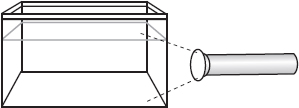

Blue Skies and Red Sunsets
Theme: God’s colorful artwork fills the skies.
Bible Verse: The heavens declare the glory of God; and the firmament shows His handiwork. (Psalm 19:1)
Materials Needed:
• Flashlight
• Large clear drinking glass or pitcher
• Drops of milk or powdered coffee creamer
Bible Lesson
We are surrounded by the beauty of God’s creation. On each new day it is easy to take many details for granted, including the clouds, blue skies, and breezes. Psalm 19 reminds us that God’s creative work is everywhere, including the skies above. Day after day the sky shows its glorious colors: bright blue by day, red and orange hues at sunrise and sunset. On the moon, in contrast, there is no air and therefore no sky color. The lunar skies are continually black, both night and day.
In nature studies there need not be a separation of science from the Bible. These two sources of knowledge work together and reinforce each other. For example, while science explains the technical formation of sky colors, Scripture explains their purpose, which is to show God’s glory and planning in the details of creation. It is God who has filled the earth with objects that are pleasant to our sight (see Genesis 2:9). Even cameras cannot fully capture the artwork of God.
Science Activity
We will illustrate how blue skies and red sunsets occur. Fill the clear container with water. Shine the flashlight through the side of the container; the beam may or may not be visible. Now mix a small amount of milk or powdered creamer into the water. The light beam should now become visible, whether or not the room is darkened. From the side the beam should be slightly blue in color. When facing the beam where it leaves the water, there should be a slight yellow appearance to the light. As more milk or powder is added to the water, the colors intensify somewhat.
The white light is partially separated into its component colors by particles in the water. The blue color is more readily “scattered” and turns the length of flashlight beam to a blue-gray color. This is similar to the blue sky that results when sunlight passes through the air. The white flashlight beam, minus the color blue, gives the slight yellow color. During sunrise and sunset, color separation is extreme and the sun becomes orange or red in appearance. The colors of our indoor experiment cannot compare with the brilliant colors of the actual sun and sky.

Small particles of milk in water will separate light into its component colors.
Science Explanation
Blue skies and red sunsets arise from the scattering of sunlight. The process was first explained by British scientists Lord Rayleigh and John Tyndall in the late 1800s. The sun’s light waves are absorbed by air molecules and then emitted again an instant later. The blue color, with a shorter wavelength than red, is more readily scattered across the sky. When the sun is low on the horizon at morning or evening, its light passes through additional air molecules and the red color now begins to scatter. Therefore the bright orange-red colors are often seen at sunrise or sunset.
The complicated process by which air molecules scatter sunlight is not fully understood by scientists. However, this display of God’s artwork in the sky can be enjoyed by all.